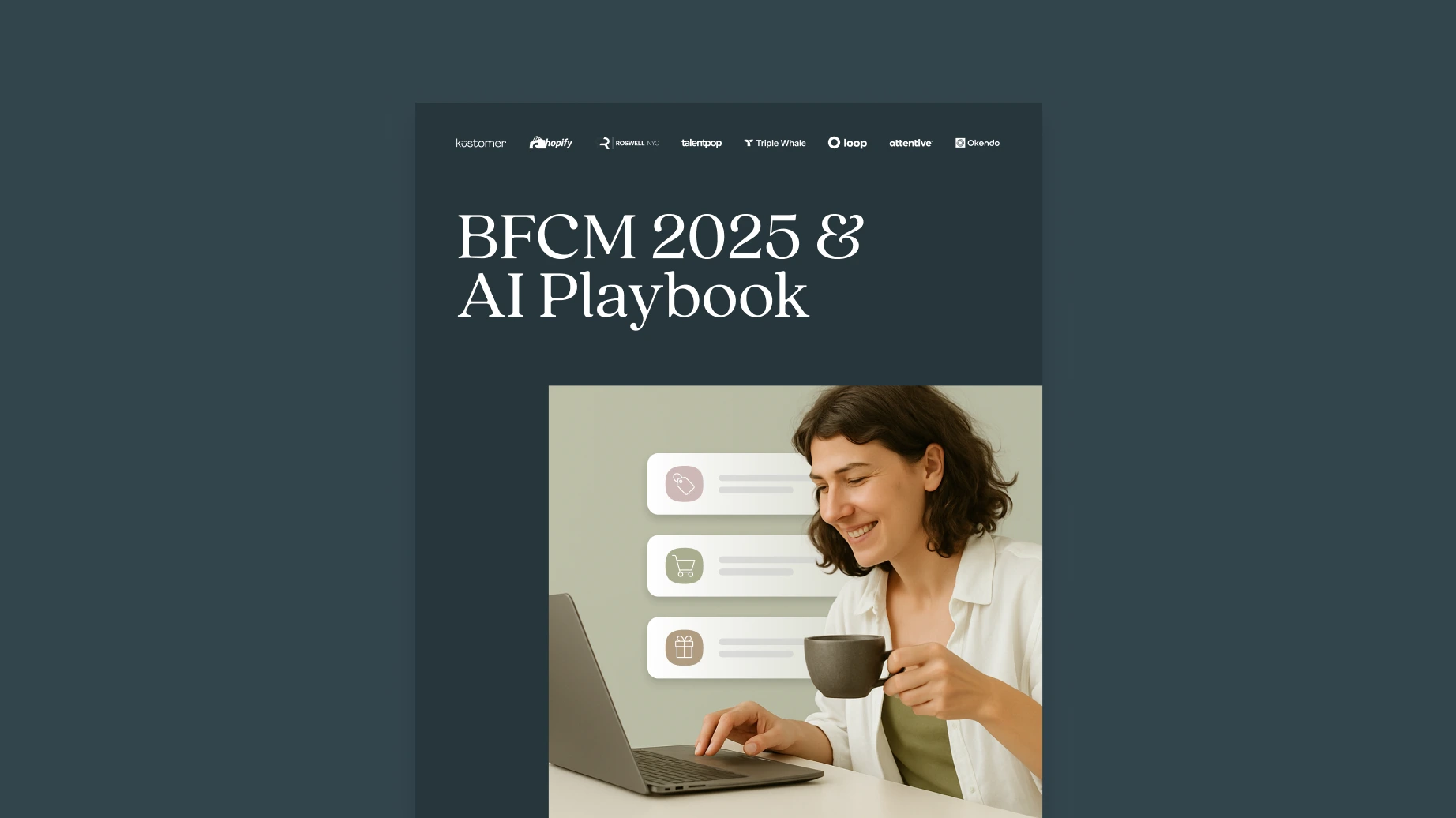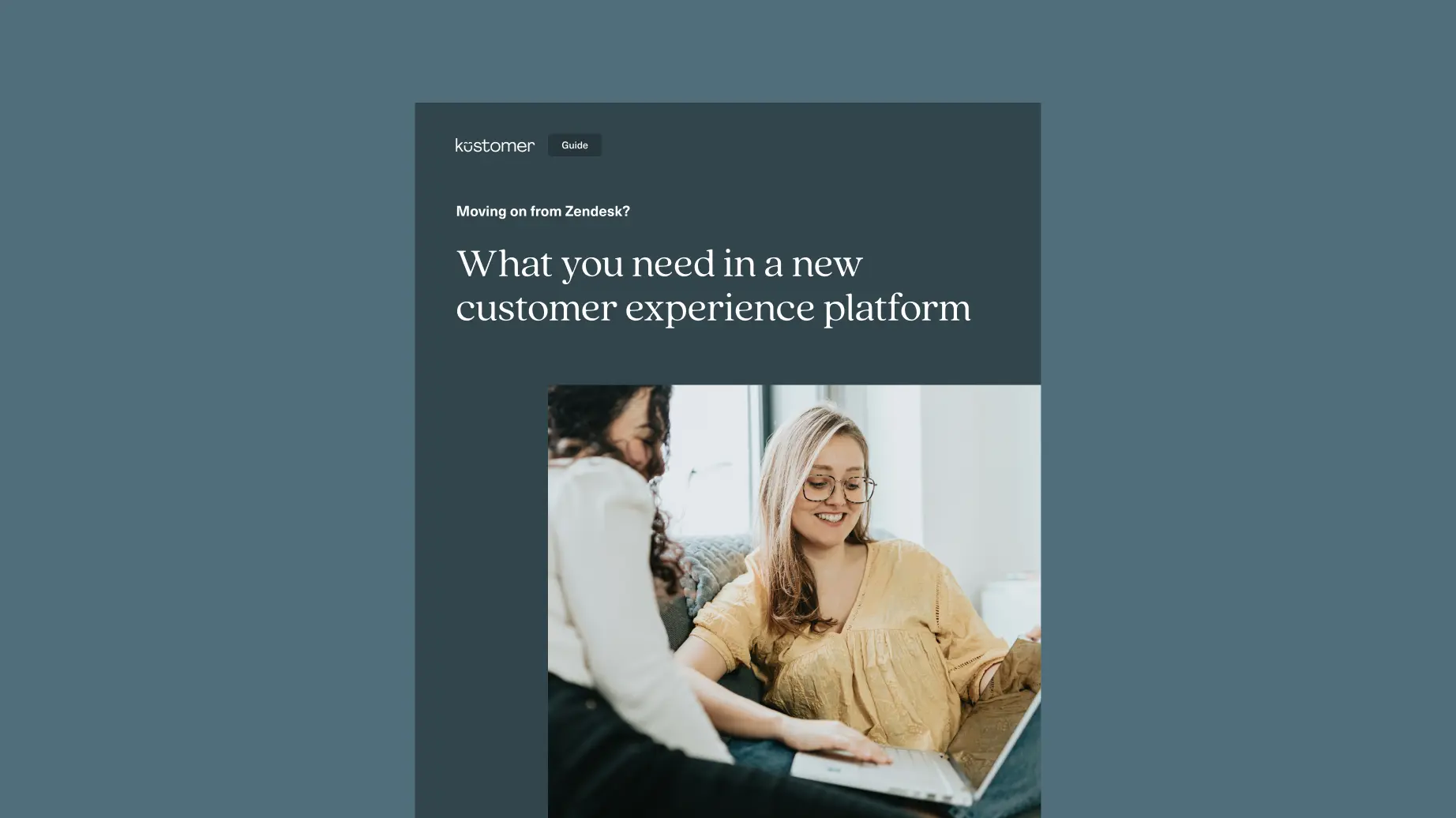Day in the life of a customer support manager:
- One agent just escalated a billing issue to three different teams—on Slack!
- A customer replied to a closed ticket because…well, they were never really answered.
- Someone somewhere just left a two-star review saying “I love the product, but support is painful.”
And there’s you, three tabs deep, two coffees in, and one unresolved ticket away from flipping your desk.
(Cheers…!?)
You’re not even asking for much. Just a system that actually… supports support.
Instead, you’re bouncing between bloated dashboards, rigid workflows and features duct-taped together by email alerts and crossed fingers.
That’s usually when someone throws the two names on the table — “Have you tried Zendesk or HubSpot.”
- HubSpot Service Hub keeps things simple. It’s already baked into your CRM, connects marketing, sales, and support, and has just enough functionality to feel unified.
- But the moment volume spikes or a customer journey goes off-script, you feel it buckle. It’s easy—until it isn’t.
- Zendesk, on the other hand, is the helpdesk veteran—built for structure, automation, and workflows at scale. It’s powerful, no doubt.
- But once you’re inside, it quickly turns into a maze of dashboards, tickets, and features that need their own onboarding plan.
One is almost too simple. The other is too much of everything. Neither solves the problem.
This guide won’t give you another feature chart or a sales pitch in disguise.
It’ll give you clarity—on what these platforms really deliver, where they quietly fall short, and what a better alternative looks like.
HubSpot Service Hub vs Zendesk: General Overview
HubSpot Service Hub Overview
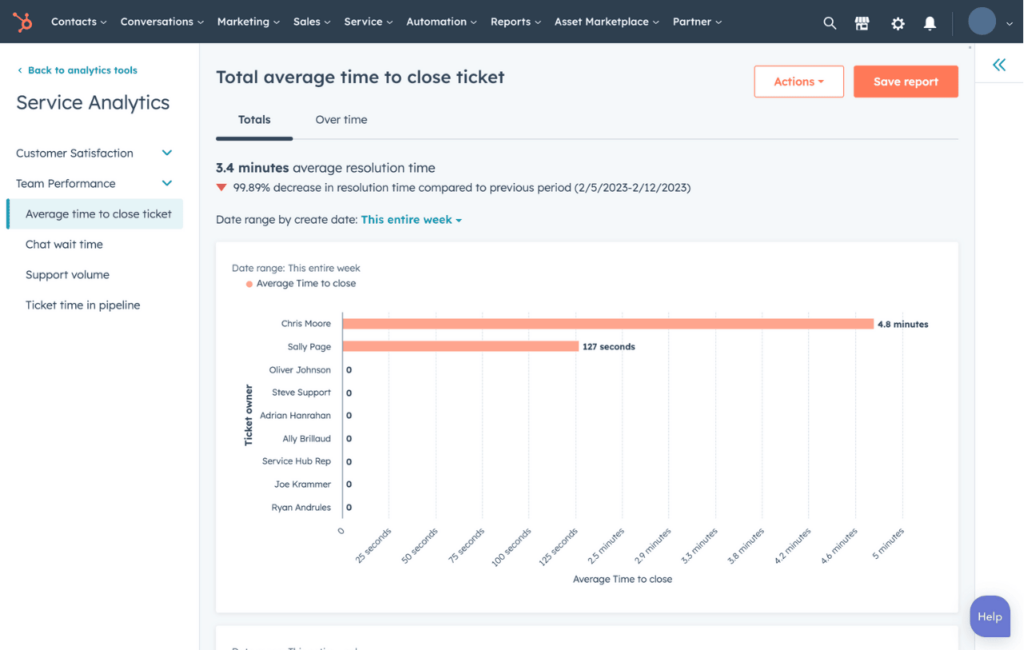
HubSpot Service Hub is HubSpot’s customer service platform built to help businesses connect support, sales, and marketing in one ecosystem.
It’s part of the broader HubSpot CRM suite, meaning its core strength lies in unifying service data with customer relationship data. This is a prime advantage for companies already using HubSpot for marketing or sales.
Furthermore, the Service Hub is built around conversations, tickets, and the shared CRM record. It enables teams to manage customer interactions across email, chat, forms, and knowledge base content from a single interface.
The platform’s design is clean, and easy to deploy, especially for lean support teams that want to avoid the complexity of enterprise platforms like Zendesk.
How It Works
Support teams in HubSpot Service Hub operate primarily from three places:
- The Conversations Inbox, where live chats, form submissions, and emails flow in
- The Tickets Pipeline, where each issue becomes a structured object that moves through defined stages
- The CRM Contact Record, where you see the customer’s full history including marketing emails, deals, tickets, notes, site activity, and more
In addition, agents can respond to customers, escalate issues, assign owners, trigger workflows, and update ticket statuses all from within these spaces.
💡HubSpot Service Hub is Best For:
- B2B companies that already use HubSpot CRM for sales/marketing
- Mid-sized teams that want clean workflows without complex configuration
- Startups or scale-ups looking for all-in-one simplicity without stitching tools together
Zendesk Overview

Zendesk is a cloud-based customer service software built to help companies manage high-volume, multi-channel customer support operations at scale.
It primarily operates on a ticket-based model. This means, every customer inquiry (whether it comes from email, live chat, web forms, messaging apps, or voice) becomes a ticket that agents can triage, assign, escalate, and resolve within a structured workflow.
How It Works
Zendesk splits the customer service experience across multiple modules, depending on the use case:
- Support. The core ticketing system where agents handle email and form-based requests
- Talk. Native voice support for call centers and inbound phone support
- Chat (Messaging). Live chat tools for websites and apps, now moving toward an asynchronous messaging model
- Guide. A self-service knowledge base to deflect tickets
- Explore. Analytics and reporting platform to measure support KPIs
- Sunshine CRM. A flexible data layer to extend Zendesk’s capabilities with custom objects and external integrations
Agents primarily work from the Support dashboard but can see real-time chat, calls, social messages, and knowledge base articles depending on how the account is set up.
💡Zendesk is Best For:
- Growing or enterprise-level support teams managing high ticket volume across multiple channels
- Businesses needing advanced workflow control, granular SLAs, and deep operational reporting
- Companies supporting multiple brands, geographies, or customer segments from a single system
Zendesk vs HubSpot Service Hub: Key Differences
Why HubSpot Service Hub is Better
- It’s Built Around the Entire Customer Journey. HubSpot Service Hub is an extension of the HubSpot CRM, meaning every customer interaction across the ecosystem is tied together naturally. Agents aren’t responding to isolated tickets; they’re engaging with customers in the context of their full journey, including past conversations, purchases, support issues, marketing activity, and sales history.
- With Zendesk, customer context exists—but it often feels bolted on top of the ticketing layer, not woven in.
- Native CRM Integration. HubSpot Service Hub is already fully embedded into the CRM. No syncing, no custom APIs, no extra data connectors needed to align support, sales, and marketing.
- With Zendesk, to replicate that alignment, you either:
- Pay extra for Zendesk Sell (their CRM platform),
- Or maintain tricky integrations with Salesforce or third-party CRMs.
- With Zendesk, to replicate that alignment, you either:
- Simpler, More Modern Agent Experience. HubSpot Service Hub is designed with a clean, intuitive interface that agents can pick up quickly. Everything (ticket status, conversations, workflows, customer history) is accessible from one screen without needing to jump across tabs.
- Zendesk is configuration-heavy. Building triggers, automations, reporting dashboards, and multi-channel flows can be time-consuming, and heavily dependent on a trained Zendesk admin.
- Integrated Feedback Loops. HubSpot Service Hub natively builds feedback collection into the customer journey—offering ready-to-use NPS, CSAT, and CES surveys that tie results back into the CRM automatically.
- Zendesk offers surveys, but typically through add-ons (like Zendesk Satisfaction Prediction) or via third-party integrations for NPS and CES.
Why Zendesk is Better
- Purpose-Built for High-Volume, Complex Support Operations. Zendesk was engineered to handle high ticket volumes, tiered agent workflows, escalations, automations, and SLA tracking with precision.
- Service Hub’s pipelines and workflows work beautifully for moderate volumes, but under heavy support loads, its system feels too simplistic.
- Deep Ticketing Customization. Zendesk lets you customize almost every part of a ticket; status fields, custom attributes, priority levels, brand-specific workflows, agent skill routing, SLA layering.
- While HubSpot offers ticket pipelines, the ability to deeply customize statuses, conditions, triggers, and workflow complexity is limited.
- Native, Full Omnichannel Support Infrastructure. Zendesk natively supports voice (Talk), SMS, email, chat, messaging, and social channels—all within one ecosystem, tailored for full-service teams.
- Service Hub’s omnichannel capabilities are mostly limited to email, chat, forms, and a lightweight inbox. Voice, SMS, and broader messaging platform integrations (like WhatsApp or Facebook Messenger) require clunky third-party apps or Zapier hacks, which break native continuity.
- Extensive Integration Ecosystem. Zendesk’s App Marketplace has over 1,300 apps—from CRM connectors to workforce management, AI integrations, telephony providers, and collaboration tools. You can also build deep customizations using Zendesk APIs, webhooks, and custom apps for agent interfaces.
- HubSpot’s app marketplace is okay, but heavily tilted toward sales and marketing apps. Service-specific integrations are more limited, especially for complex customer service operations (like telephony, QA platforms, and WFM solutions).
| Category | HubSpot Service Hub | Zendesk |
| Core Focus | Customer relationship management integrated with service | Ticket management and omnichannel support at scale |
| Platform Architecture | CRM-first; service is an extension of customer record | Ticket-first; customer context layered onto tickets |
| Ease of Use | Intuitive, clean interface; low learning curve | Powerful but steeper learning curve; more complexity as you scale |
| Automation | Visual drag-and-drop workflows; easy for non-technical teams | Highly customizable triggers, automations, and SLAs; better for operational teams |
| Omnichannel Support | Email, chat, simple voice integration, feedback surveys | Deep native support across email, chat, messaging apps, SMS, and voice |
| Knowledge Base | SEO-optimized knowledge base included; straightforward | Full help centers, multi-brand portals, customer forums, answer bots |
| Reporting and Analytics | Clear, useful dashboards integrated into CRM | Deep operational analytics via Zendesk Explore; high customizability |
| Customization and Integrations | Strong inside HubSpot ecosystem; lighter third-party extensibility | Large app marketplace (1,300+ apps); advanced APIs and custom apps |
| Self-Service Capabilities | Knowledge base and basic feedback automation | Advanced self-service with communities, AI surfacing, and permissions management |
| Scalability | Scales with growing CRM needs; limited operational complexity | Scales deeply across brands, regions, channels, and complex support teams |
💡Verdict:
- Choose HubSpot Service Hub if you want a unified, CRM-centered customer experience platform that’s easy to manage and scales with growth.
- Choose Zendesk if you need a powerhouse ticketing and workflow system designed to support large-scale, structured support operations.
💡Better Conversations Start Here: Meet Kustomer
Here’s the thing: Neither HubSpot Service Hub nor Zendesk was originally built for modern, unified customer service.
- HubSpot Service Hub grew out of a marketing and sales platform—great if you want CRM alignment, but stretched thin when you really need serious support infrastructure.
- Zendesk offers structure, but at the cost of agility. Everything becomes a ticket, a workflow, a dashboard—and soon, you’re managing the system more than managing customers.
Kustomer is different. Not because we say so, but because it was designed from day one for modern CX teams who demand context, connection, and control.
Seamless Omnichannel Support
In Kustomer, all channels flow into the same conversation stream; email, chat, SMS, social messaging, WhatsApp, phone—all native, all unified.
Agents work from a single view, easily toggling channels without switching screens or losing context.
What that means for you:
- No more piecing together conversations across platforms.
- No channel gets treated as second-class.
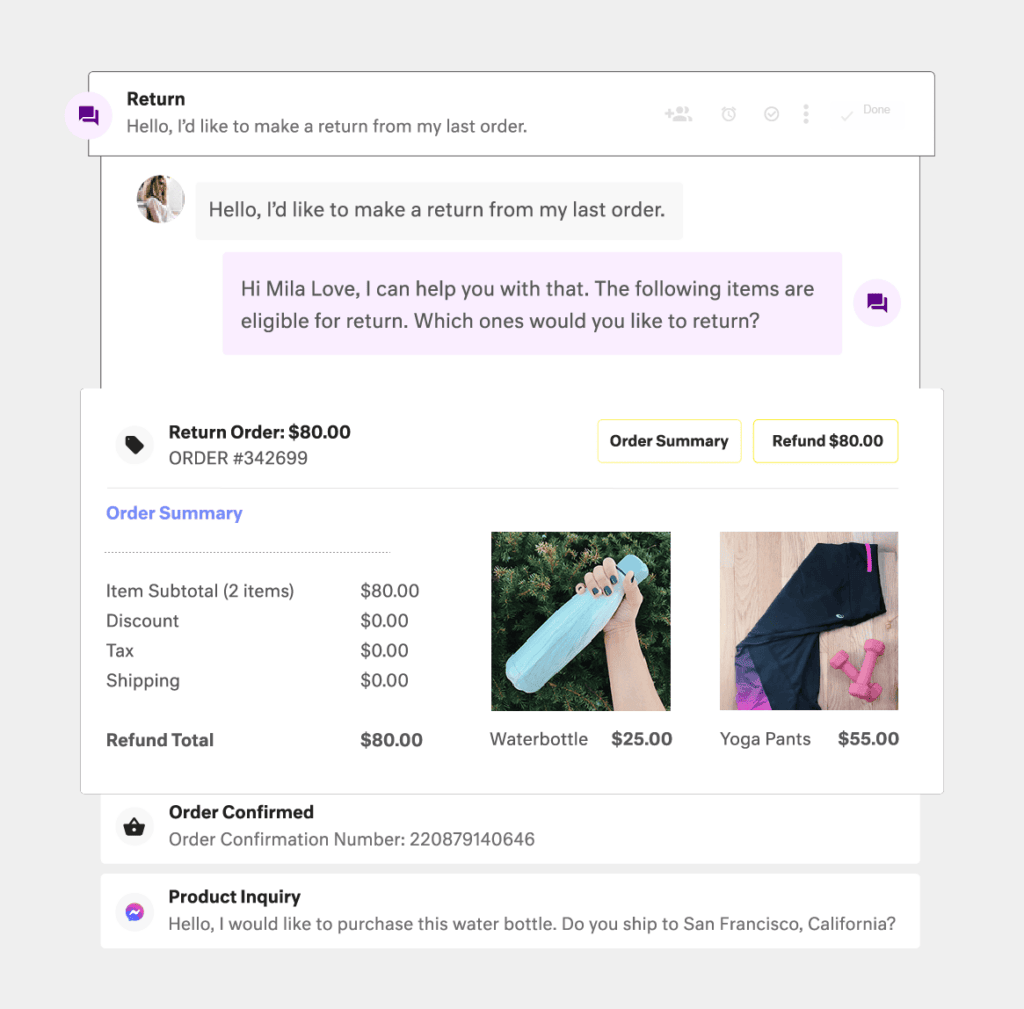
Automation That Actually Reflects Your Business
Kustomer’s workflow builder allows you to design automations visually based on your real-world processes, not some rigid support template.
With this, you can:
- Escalate tickets automatically based on account type or SLA risk.
- Trigger proactive outreach if a high-value customer leaves negative feedback.
- Route conversations dynamically based on issue type, location, or customer tier.
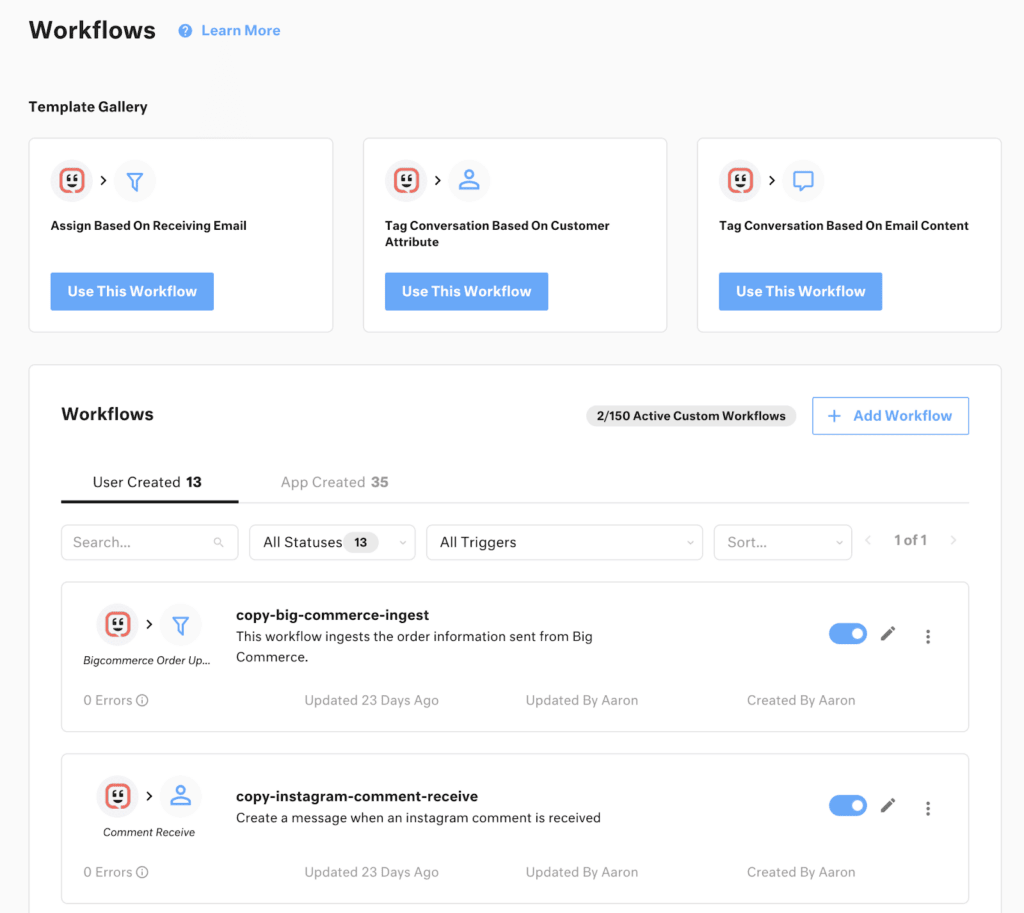
What that means for you:
- Automations that feel natural, not forced.
- More coverage without needing more headcount.
Built Around Customers, Not Tickets or Channels
Kustomer displays every order, conversation, survey response, and case history along a real-time, unified timeline.
Agents aren’t just answering questions—they’re interacting using full customer journey with instant, actionable context.
What that means for you:
- Less time digging for answers.
- More personalized, empathetic responses.
Native CRM Capabilities for Complete Customer Visibility
Kustomer comes with CRM functionality built-in. No need to sync external platforms or stitch together partial profiles. You can track purchase history, subscription status, custom attributes, and lifecycle stages—all in the same system your agents use daily.
What that means for you:
- Instant personalization across every conversation.
- Richer reporting on customer lifetime value and service impact.
- Better handoffs between support, sales, and success teams.
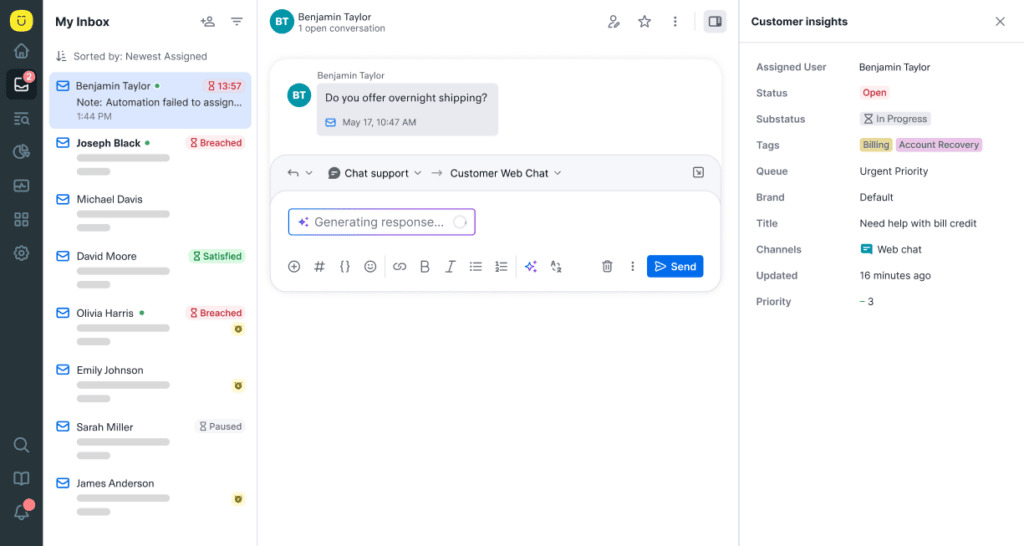
Scales Without Breaking Things
Kustomer was built to scale naturally, handling multi-brand operations, multi-language support, regional teams, and heavy ticket loads without requiring endless custom admin work.
This includes flexible SLA policies, multiple business units, advanced permissioning, and deep reporting all come standard at scale.
What that means for you:
- You can add teams, brands, or markets without starting from scratch.
- You don’t have to rebuild workflows just because you grew 2x faster than expected.
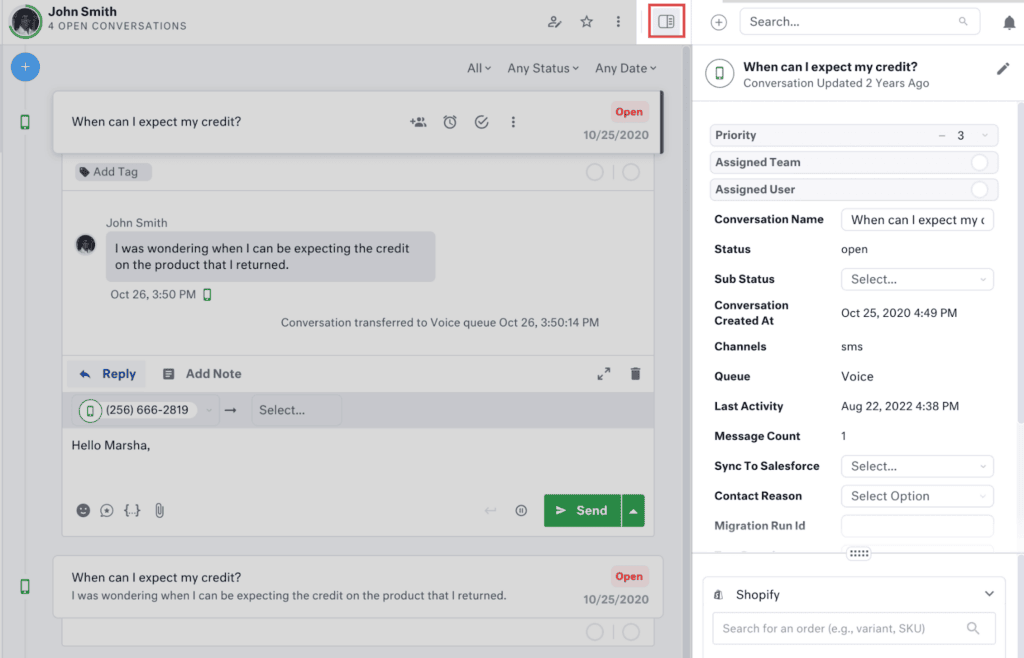
In the end, Kustomer isn’t trying to be a “middle ground” between complexity and simplicity.
It’s trying to rewrite the experience entirely:
- For support teams tired of duct-taping systems together.
- For agents tired of chasing context.
- For customers who deserve a conversation, not a case number.
Built for modern teams. Perfect for yours. Make the switch →
HubSpot Service Hub: Features, Use Cases, Pricing, Pros & Cons
Key Features
- Conversations Inbox. A shared, collaborative inbox that handles emails, live chat, and form submissions in one view. Agents can assign conversations, leave notes, and reply directly.
- Help Desk Automation. Helps automate ticket routing, task creation, and service workflows with HubSpot’s built-in automation engine. You can set rules that automatically assign tickets based on priority, agent expertise, or ticket type.
- Customer Portal. Gives customers their own personalized space to track the status of their support tickets, access updates, and communicate with your support team. It’s also fully connected to your ticketing system, increasing transparency and improving the overall customer experience.
- Knowledge Base Builder. Lets you build a branded, searchable library of help articles, FAQs, and documentation. The knowledge base is designed to integrate directly into your ticketing and chatbot systems to deflect tickets by offering self-service support options to customers.
- Ticket Pipelines. Customizable pipelines that help you manage the lifecycle of service tickets through different stages, similar to sales pipelines. For example; New → In Progress → Waiting → Closed. You can also build multiple pipelines for different teams or use cases.
Main Use Cases
- Managing Customer Support Tickets with CRM Context. Service Hub is ideal for businesses that want every support ticket to live inside a larger customer profile, rather than an isolated case. When a customer submits a ticket, agents instantly see their full history: past purchases, marketing touchpoints, open deals, and more.
- This makes it easier to personalize responses, anticipate needs, and spot upsell or retention opportunities.
- Creating Unified Customer Communication Across Channels. Through the Conversations Inbox, HubSpot centralizes communication across email, chat, forms, Facebook Messenger, and WhatsApp.
- This setup works perfectly for teams that want to manage all customer interactions in one place, making it easier to prioritize, assign, and follow up without context switching between tools.
- Building and Scaling Self-Service Knowledge Bases. For companies that want to reduce repetitive tickets and empower customers to self-serve, HubSpot’s knowledge base tools make it simple to launch and manage public help centers.
- Content is easily searchable, SEO-friendly, and automatically connected to ticket deflection bots.
- Supporting Revenue Growth through Service. Because Service Hub is connected to CRM data, service teams can also be active participants in upsell, cross-sell, or retention efforts.
- Agents can identify opportunities based on customer behavior, satisfaction scores, product usage, or deal activity.
Related reading → 10 Popular HubSpot Service Hub Alternatives to Consider
HubSpot Service Hub Pricing Breakdown (The Friendly Face With Fine Print)
HubSpot Service Hub offers three main pricing tiers: Starter, Professional, and Enterprise.
Each step up unlocks more powerful automation, customization, and reporting features.
- Starter. Starts at $20 per seat/month.
- Professional. Starts at $90 per seat/month.
- Enterprise. Starts at $150 per seat/month.
⚠️Here’s Where The Cheap… is not Cheap
- Seats = Costs Spiral Quickly. HubSpot charges per agent seat, no matter how small the role. Even part-time support reps, success team members handling tickets, or internal users need full paid seats. As your team grows, your costs can rise faster than planned.
- Add-Ons Are Often Unavoidable. Many Service Hub users eventually find themselves needing access to HubSpot’s broader ecosystem—e.g.,
- Operations Hub (for advanced data syncing, custom objects) or Marketing Hub (to automate customer communications). That means you’re not just paying for Service Hub—you’re building toward a multi-hub stack, each with separate pricing tiers.
- Starter Plan Is Often Too Basic. In theory, $20/seat/month sounds like a deal. But in practice, serious customer support teams almost always outgrow Starter within months. Key must-haves like SLA management, workflow automation, and knowledge base functionality only exist at Professional or higher.
- Volume Limits Exist (and Can Hurt). Even with Professional and Enterprise plans, HubSpot imposes limits around:
- Number of customer feedback surveys
- Reporting customization depth
- Custom objects and record counts
- API usage volume. Once you pass certain thresholds, you’ll face extra fees—or get forced into additional hubs or tier upgrades.
🎯In Summary:
Assume Starter is just a warm-up. Plan for Professional or Enterprise as soon as you see even mild complexity on your support team.
And remember: HubSpot isn’t just selling you support — they’re selling you an ecosystem. Choose wisely.
Pros
- Easy to Set Up and Use. HubSpot Service Hub is praised for its intuitive, user-friendly interface, making it accessible even to users without technical backgrounds. Setup is fast, and the platform doesn't require developer support for basic workflows, automations, and ticketing [*].
- All-in-One Customer Service Management. The Service Hub centralizes customer issues, allowing teams to assign, track, and resolve tickets efficiently. Customers can also monitor the status of their inquiries in real time, improving transparency and satisfaction [*].
- Strong Customization and Integration Capabilities. Users can personalize dashboards, create smart workflows, automate tasks, and integrate with a wide range of apps. Autopopulating company data from just a URL saves time during account setup [*].
- Great for Visibility and Collaboration. Managers and teams can easily see all activities, deals, and contact statuses without needing constant manual updates, improving follow-ups and reducing internal communication gaps [*].
Cons
- User Interface Changes Can Disrupt Workflow. Frequent UX updates make it harder for some users to build long-term familiarity with the platform. Newcomers may struggle initially with the navigation and understanding available tools [*].
- Integration Stability Issues. Some platform integrations, such as LinkedIn, can be glitchy, leading to inefficiencies and frustrations when managing cross-channel activities [*].
- Upgrade Costs for Key Features. Essential actions like bulk duplicate cleanup or advanced reporting often require upgrading to a higher-priced plan, which can feel restrictive for businesses already on paid subscriptions [*].
- Occasional Issues With Ticket Merging. Conversations sometimes become harder to trace after merging tickets, leading to occasional confusion when managing customer interactions across multiple threads [*].
💡Alternative to HubSpot Service Hub: Kustomer
Service Hub is simply an extension of a CRM platform cosplaying as a customer service solution.
It gets you started fast, sure. But soon, you’ll find yourself patching around limitations with external tools, and awkward CRM workarounds just to get by.
Kustomer offers a fix to that that puts the customer at the center by unifying conversations, orders, journeys, and histories into a single, clean timeline.
Here’s what means to you:
- Custom Workflows Without Needing a Developer. Build powerful automation across channels, ticket types, and agent actions — without begging IT for help. Drag. Drop. Done.
- True Personalization at Scale. Kustomer shows you customer data and lets agents act on it instantly: refunds, order adjustments, VIP tagging, loyalty perks, you name it.
- Try pulling that off smoothly inside HubSpot without 10 custom CRM fields.
- AI that Feels Like a Teammate. Kustomer’s AI (KustomerIQ) suggests help articles, predict intent, automates conversations, and escalates issues proactively. Never have to worry about doing it manually.
Marketing’s fun. Support’s critical. Kustomer gets it. Make the switch →
Zendesk: Features, Use Cases, Pricing, Pros & Cons
Key Features
- Agent Workspace. A unified interface that unifies all customer conversations across all channels into a single, continuous thread. Agents can switch between channels without losing context, making multichannel support seamless.
- Answer Bot. An AI-powered bot that automatically suggests relevant help center articles to customers based on the content of their inquiry.
- Custom Ticket Fields and Forms. Allows you to create tailored ticket submission forms and custom fields to collect specific customer information at the point of contact.
- Zendesk Sunshine. A flexible CRM layer that allows businesses to create custom objects, link customer data from external systems, and build personalized workflows.
- Macros, Triggers, and Automation. This is Zendesk’s workflow engine allows you to automate ticket routing, escalations, status changes, follow-ups, and notifications based on ticket attributes or time conditions. There are three automation layers:
- Triggers. Event-based rules that fire when conditions are met (e.g., if ticket is tagged “urgent,” alert the manager)
- Automations. Time-based workflows (e.g., escalate tickets that have been open for 24+ hours)
- Macros. Pre-built responses and actions agents can trigger with one click (e.g., closing a ticket and sending a satisfaction survey).
Main Use Cases
- Managing Complex, Multi-Brand Support Operations. With Zendesk, each brand can have its own help center, SLA policies, workflows, and agent teams, all managed from one admin backend.
- This makes Zendesk a strong fit for companies with multiple product lines, subsidiaries, or regional divisions that still want unified oversight.
- Building Self-Service Ecosystems. Beyond ticket handling, Zendesk Guide enables businesses to launch robust help centers, customer communities, and FAQs that deflect common inquiries before they ever reach an agent.
- Companies that want to drive down ticket volume and improve customer self-sufficiency at scale—particularly SaaS, eCommerce, and tech firms—can leverage Zendesk’s self-service heavily.
- Managing High-Volume, Multi-Channel Ticket Workflows. Zendesk’s ticketing system is purpose-built for companies handling large support volumes across email, chat, voice, messaging apps, and social media.
- Tickets flow into a single queue where teams can prioritize, categorize, escalate, and resolve issues based on pre-set rules.
- Enforcing SLA Compliance and Priority Management. Organizations with strict service-level agreements can rely heavily on Zendesk’s native SLA management features.
- Teams can define custom SLAs by customer segment, ticket priority, or channel, and Zendesk automatically tracks compliance, triggers escalations, and alerts managers when thresholds are at risk.
Zendesk Pricing Breakdown (...And the Admin Headaches)
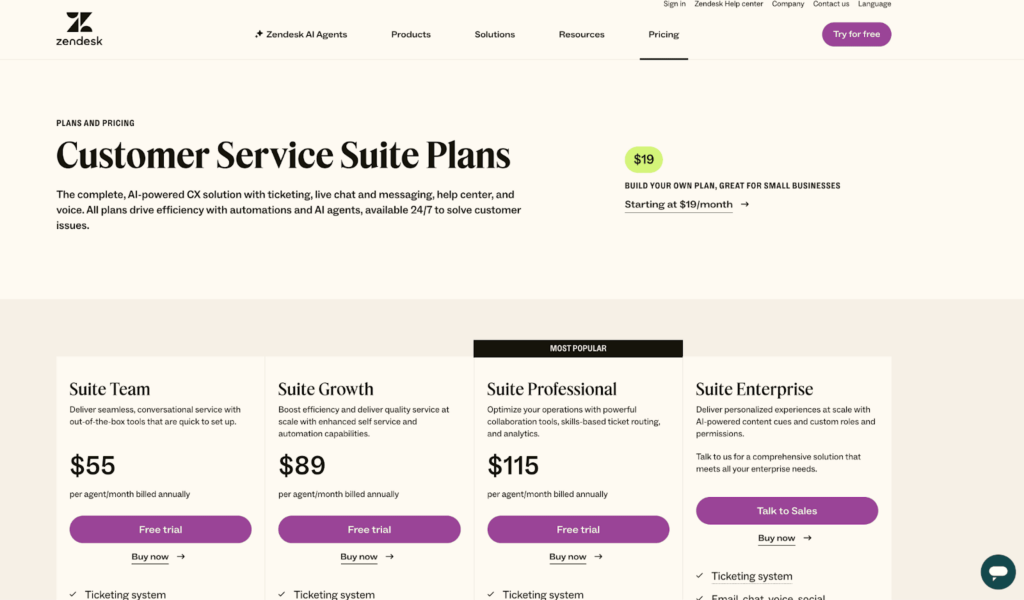
On the Zendesk Suite (all-in-one) plan, you’ve got four options:
Zendesk offers different pricing options depending on your budget, needs, and selective support needs.
However, for this comparison we’ll be covering the Zendesk Suite plan which bundles its core tools (Support, Guide, Chat, Talk, Messaging) into one:
- Suite Team. $55 per agent/month.
- Suite Growth. $89 per agent/month.
- Suite Professional. $115 per agent/month.
- Suite Enterprise. $169 per agent/month.
- Suite Enterprise Plus. Custom pricing.
Add-ons:
- Copilot. $50 per agent/month for AI-powered tools for agents
- Workforce Management. $25 per agent/month for scheduling and performance tracking
- Quality Assurance. $35 per agent/month for conversation analysis and coaching
- Workforce Engagement Bundle. $50 per agent/month—Combines WFM and QA
- Advanced Data Privacy and Protection. $50/agent/month for enhanced security features.
These bundles are what most mid-size to large companies end up using because standalone Support plans lack modern messaging features.
⚠️ Now, The Part They Don’t Tell You (Until It’s Too Late)
- Essential Features Are Gated at Higher Tiers. Basic plans look attractive but miss critical capabilities like SLA timers, multi-channel integrations, or workflow flexibility that any scaling support team inevitably needs.
- You’ll almost always be forced into Professional or Enterprise tiers to enjoy the platform.
- Annual Billing Locks You In. Zendesk heavily encourages annual contracts — with enticing discounts compared to monthly plans. But here’s the catch:
- Monthly billing costs noticeably more (sometimes 20–30% higher), almost punishing you for not committing.
- Need to downgrade or pause? Almost impossible because annual contracts are rigid. You’ll either eat the cost or negotiate (and Zendesk isn’t exactly famous for refund flexibility).
- Worse, if you’re planning to scale back mid-year because of budget cuts or seasonality, it’s not happening. You’re locked until renewal time.
- Custom Development Costs Extra (And You’ll Probably Need It). Yes, Zendesk can be customized to fit your perfect customer experience vision; multiple brands, intricate workflows, integrated back-end systems, shiny custom widgets. But:
- Deep customizations often need a dedicated Zendesk developer.
- Complex needs (like multi-region data routing, field service management, or truly unique agent workflows) will almost always push you toward Zendesk’s Professional Services team—which isn’t cheap.
- Alternatively, you might have to rope in third-party implementation partners — another expense outside your subscription.
🎯In Summary:
- Treat Zendesk pricing like iceberg math: whatever you see on the page, expect 30-50% more lurking underneath the surface.
- And never — seriously, never — skip a deep requirements mapping before you sign that first contract.
Related → Is Zendesk Worth It? Hmm... See The Pros & Cons
Pros
- Centralized Communication Hub. Zendesk pulls together email, chat, phone, messaging apps, and social media into a single platform. It gives agents full visibility into customer conversations across channels, making it easier to deliver consistent support [*].
- Flexible Automation and Ticket Routing. With powerful triggers, automation rules, and skills-based routing, Zendesk helps teams manage tickets more efficiently. It’s also flexible enough to handle the complex needs of larger organizations [*].
- Easy Team Collaboration. Zendesk makes it simple for multiple agents to collaborate on tickets in real time, which helps teams share knowledge faster and resolve issues quicker [*].
- Seamless Integrations. Zendesk connects easily with major platforms like Salesforce, Jira, and internal systems, helping businesses keep workflows organized without needing to juggle multiple tools [*].
Cons
- Advanced Features Often Need Developer Help. While Zendesk is easy to use for basic tasks, setting up advanced features usually requires backend work or technical support [*].
- Longer Setup Process. Getting Zendesk fully customized, especially when setting up workflows and reports tailored to your business, can take more time and effort than expected [*].
- Service Outages Happen. Some users have reported frequent platform outages and email notifications about service disruptions, affecting overall reliability [*].
- Steep Learning Curve for Admins. Managing Zendesk on the backend, particularly for complex setups, takes time and experience to navigate properly [*].
💡Alternative to Zendesk: Kustomer
Zendesk gets a lot of things right: features, customization, flexibility — you name it.
But it’s also bloated, fragmented, and stuck in a ‘ticket-first’ model. Every module feels like a different tool patched to the last one.
And somehow, you’re paying more, waiting longer, and bending your service around Zendesk’s system—not the other way around.
We don’t think that’s right. So we built Kustomer differently — around managing customer relationships and not tickets.
- Automation Without an Instruction Manual. Kustomer’s visual workflow builder makes it easy to automate complex processes—without needing a Zendesk-certified admin to write triggers and hope they don’t conflict.
- Data-First, Not Ticket-First. Kustomer acts like a CRM from day one. You can manage orders, product usage, device details, memberships. No need for Sunshine, Salesforce, or fragile third-party integrations.
- Reports That Show More Than “Closed Ticket Volume”. See customer health trends, identify expansion opportunities, flag churn risks—all directly from your support platform.
- Grows With You, Not Against You. Whether you have 5 agents today or 500 tomorrow, Kustomer flexes. No need to buy six different add-ons just to handle more channels, launch a new brand, or offer proactive support.
Zendesk was great... for 2010. Kustomer’s built for what’s next. Make the switch →
What to Know Before You Pick Your Next Support Tool
Understand Your Support Channels — Now and Later
- Start by mapping out how your customers reach you today:
- Is it via email, live chat, phone, messaging apps (like WhatsApp or Messenger), social media, or community forums?
- Different platforms specialize in different channels: some are ticket-centric (email/web forms first), others are conversation-centric (chat-first), and a few try to blend both.
- Also project forward:
- Are you planning to add voice support soon?
- Will you need to manage SMS or in-app chat as you scale?
- Choose a tool that can handle your current channels and also grow with you without needing external integrations for simple modifications.
💡Pro Tip → Create a table listing all your current channels versus emerging channels you might need in 12–24 months (like in-app chat, WhatsApp, or embedded support widgets).
Then, for each potential vendor, color-code how well they handle each. This avoids a mismatch where a platform fits today but blocks you tomorrow.
Consider Ease of Use for Agents and Admins
A fancy, feature-loaded tool means nothing if your team can’t use it efficiently.
You want a platform that feels intuitive from day one; both for agents handling customer conversations and admins setting up workflows, automations, and reporting.
During demos, ask questions like:
- How many clicks does it take to escalate or transfer a ticket?
- How customizable are workflows without needing developers?
- How steep is the learning curve for onboarding new agents?
The faster your team gets productive, the faster you deliver better customer experiences.
💡Pro Tip → Sketch the types of workflow edits and reporting tweaks you expect after launch (e.g., adjusting priority tags, creating new escalations).
Then, put an agent to try out the platform without formal training. If they’re stuck Googling basic tasks, your team will struggle post-rollout.
Prioritize the Right Channels
Some customer service tools are strong in email support but weak in live chat or social media messaging. Others might be great for live chat but clunky when managing complex ticket histories.
You need to prioritize based on your audience’s habits and your business goals:
- Heavy e-commerce? You’ll likely need fast live chat and SMS support.
- B2B SaaS? Email-based ticketing and knowledge bases matter more.
- Global customers? Look at tools with multilingual support and 24/7 self-service options.
💡Pro Tip → Opt for solutions where channel expansion is included or easily enabled without major fees. This protects you from future upgrade surprises.
Evaluate Customization and Automation Options
Every business has quirks. You will inevitably need to customize how tickets are routed, categorized, prioritized, or escalated.
A good support platform should give you strong customization power without forcing you into complex, developer-heavy setups every time.
Key things to check:
- Workflow builders: Visual and no-code?
- Macros, triggers, automation rules: How flexible are they?
- AI capabilities: Can the platform intelligently categorize, route, and even suggest replies?
💡Pro Tip → Request a few real-world automation examples (like SLA breach alerts or auto-tagging VIP customers) from each vendor.
If they can’t show these without heavy scripting, it’s a red flag for future flexibility.
Factor in Onboarding, Training, and Support (Yes, You’ll Need It)
Switching support tools is disruptive, no matter how “easy” the vendor claims the migration will be.
You need a tool with strong onboarding, accessible support resources, and ideally, a dedicated customer success team for more complex rollouts.
Otherwise, you risk a chaotic transition period that impacts customer experience.
- Is there a knowledge base or academy for your agents?
- Are there 24/7 support options if you get stuck?
- Will you have access to hands-on onboarding specialists?
💡Pro Tip → During evaluation, demand to see:
- Support SLAs by issue severity (e.g., critical issues resolved within X hours).
- Onboarding-specific escalation paths if the initial setup breaks workflows.
- Whether you'll have a dedicated implementation manager or just “self-serve” help.
Evaluate Reporting, Analytics, and Visibility
If you can’t measure it, you can’t improve it. Basic tools offer metrics such as “number of tickets solved” dashboards, but that’s not enough.
You need deep, actionable insights:
- Time to first response
- Time to resolution
- Ticket backlog trends
- Agent performance breakdowns
- Customer satisfaction (CSAT), NPS, or other feedback integrations
Also, consider how flexible reporting is. Can you segment by product line? Customer type? Support channel?
💡Pro Tip → Simulate critical queries like:
- “Show me first response time segmented by shift team across three regions.”
- “Pull escalation rate for VIP customers over the last 90 days.”
- “CSAT by product line and agent tenure.”
This exercise will reveal whether the platform can give you the diagnostic visibility needed to improve.
Understand Total Cost of Ownership — Not Just the Sticker Price
Most vendors highlight their cheapest per-seat number upfront. Always ask for a total cost of ownership (TCO) estimate covering your expected team size, add-ons, and growth for the next 2–3 years.
Consider:
- Implementation costs (initial setup, migration from old systems)
- Integration costs (connecting your CRM, chat apps, internal tools)
- Add-on feature fees (e.g., advanced analytics, AI bots)
- Hidden limitations (e.g., API access only available on premium plans)
A cheaper plan that requires buying a bunch of third-party apps to be functional could cost you more in the long run than a more expensive but all-in-one platform.
💡Pro Tip → Build three realistic expansion scenarios:
- Moderate growth (e.g., +5 agents/year, no major features added).
- Aggressive growth (e.g., +10 agents/year, adding advanced reporting, AI automation, new channels like WhatsApp).
- Pivot scenario (e.g., major team restructure requiring new admin roles, API usage, custom integrations).
Ask the vendor to price out all three during evaluation.
This method exposes hidden thresholds (like when “premium” features suddenly become mandatory).
It also catches future instances like API call limits, per-report fees, or costly required upgrades once you cross user tiers.
Kustomer > The Rest. Your Move.
That’s a bold statement — you’d agree.
But if you’ve made it this far, you already know it’s true.
Because if Zendesk or HubSpot were really enough, you wouldn’t still be searching. Googling “better support platforms” at 10PM, hoping there’s something out there that actually makes sense.
Or explaining to your team (again) why the system “just works differently” for escalations (because it doesn’t).
With Kustomer — we took a unique approach.
- You get one view of the entire customer journey.
- One conversation that doesn’t get lost across tickets, agents, or channels.
- Full context at your agents’ fingertips, so they can solve problems without second-guessing.
- Full control over workflows, automation, and personalization—without drowning in dashboards you’ll never use.
And all of it is built around the customer, not the case number.
Chad Warren, SR. Manager of Customer Service at Vuori, puts it like this:
Because when support actually works the way it should, customers don’t notice the system—they just notice how easy it felt.
Your customers deserve better. So does your team. Try Kustomer.


